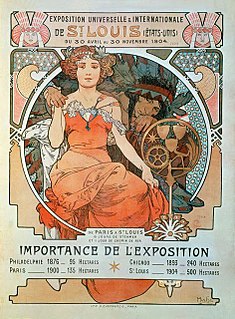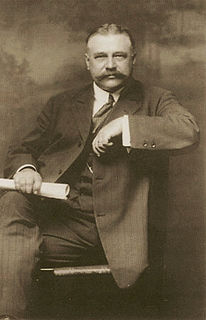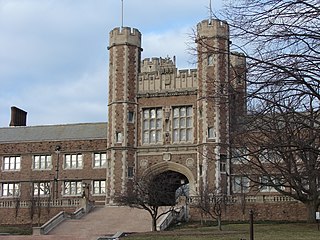
The Louisiana Purchase Exposition, informally known as the St. Louis World's Fair, was an international exposition held in St. Louis, Missouri, United States, from April 30 to December 1, 1904. Local, state, and federal funds totaling $15 million were used to finance the event. More than 60 countries and 43 of the then-45 American states maintained exhibition spaces at the fair, which was attended by nearly 19.7 million people.

Cass Gilbert was a prominent American architect. An early proponent of skyscrapers, his works include the Woolworth Building, the United States Supreme Court building, the state capitols of Minnesota, Arkansas and West Virginia; and the Saint Louis Art Museum and Public Library. His public buildings in the Beaux Arts style reflect the optimistic American sense that the nation was heir to Greek democracy, Roman law and Renaissance humanism. Gilbert's achievements were recognized in his lifetime; he served as president of the American Institute of Architects in 1908–09.

Forest Park is a public park in western St. Louis, Missouri. It is a prominent civic center and covers 1,326 acres (5.37 km2). Opened in 1876, more than a decade after its proposal, the park has hosted several significant events, including the Louisiana Purchase Exposition of 1904 and the 1904 Summer Olympics. Bounded by Washington University in St. Louis, Skinker Boulevard, Lindell Boulevard, Kingshighway Boulevard, and Oakland Avenue, it is known as the "Heart of St. Louis" and features a variety of attractions, including the St. Louis Zoo, the St. Louis Art Museum, the Missouri History Museum, and the St. Louis Science Center.
KETC, virtual channel 9, branded on air as Nine PBS, is a Public Broadcasting Service (PBS) member television station licensed to St. Louis, Missouri, United States. The station is owned by St. Louis Regional Public Media. KETC's studios are located at the Dana Brown Communications Center on Olive Street in St. Louis' Grand Center neighborhood, and its transmitter is located in South St. Louis County. On cable, the station is available on Charter Spectrum channel 9 in both standard and high definition, and on AT&T U-verse channels 9 (SD) and 1009 (HD).

Edward Gardner Lewis was an American magazine publisher, land development promoter, and political activist. He was the founder of two planned communities that are now cities: University City, Missouri, and Atascadero, California. He created the American Woman's League (1907), a benefits fund for women who sold magazine subscriptions, as well as the American Woman's Republic (1911), a parallel organization designed to help women prepare themselves for a future in which they would have the right to vote. He also founded the People's University and its associated Art Academy in University City, as well as two daily newspapers and two banks.

The Grand Center Arts District is located in the Midtown St. Louis Historic District north of the Saint Louis University campus. Referred to colloquially as Grand Center, the neighborhood's formal name is Covenant Blu Grand Center. The neighborhood is a member of the Global Cultural Districts Network.

George Edward Kessler was an American pioneer city planner and landscape architect.

The Missouri History Museum in Forest Park, St. Louis, Missouri, showcases Missouri history. It is operated by the Missouri Historical Society, which was founded in 1866. The main galleries of the museum are free through a public subsidy by the Metropolitan Zoological Park and Museum District.

The Fox Theatre, a former movie palace, is a performing arts center located at 527 N. Grand Blvd. in St. Louis, Missouri. Also known as "The Fabulous Fox", it is situated in the arts district of the Grand Center area in Midtown St. Louis, one block north of Saint Louis University. It opened in 1929 and was completely restored in 1982.
The Memorial Coliseum was an arena in Corpus Christi, Texas that had a capacity of about 3,000 which was demolished in June 2010.

Theodore C. Link, FAIA, was a German-born American architect and newspaper publisher. He designed buildings for the 1904 World's Fair, Louisiana State University, and the Mississippi State Capitol.

Midtown is a neighborhood in St. Louis, Missouri. It is located 3 miles (4.8 km) west of the city riverfront at the intersection of Grand and Lindell Boulevards. It is home to the campus of Saint Louis University and the Grand Center Arts District.

St. Louis Exposition and Music Hall was an indoor exposition hall, Music Hall and arena in St. Louis, Missouri from 1883 to 1907.

The Saint Louis Exposition or St. Louis Expo was a series of annual agricultural and technical fairs held in St. Louis' Fairgrounds Park, from the 1850s to 1902. In 1904, the Louisiana Purchase Exposition, a major World's Fair, was held in St. Louis, Missouri. The annual agricultural/technical exposition was not held in 1903-4, and ceased after the World's Fair. Memorabilia from the annual St. Louis Expositions are sometimes confused with 1904 World's Fair memorabilia on auction websites.

The Washington University Hilltop Campus Historic District was the site of the 1904 Louisiana Purchase Exposition and the 1904 Summer Olympics. Many of the exposition buildings were temporary in nature, but a number of permanent structures were built and are used by Washington University, which calls this area the Danforth Campus. The district includes more than fifty structures, of which twenty are in the Collegiate Gothic style.

The architecture of St. Louis exhibits a variety of commercial, residential, and monumental architecture. St. Louis is known for the Gateway Arch, the tallest monument constructed in the United States. Architectural influences reflected in the area include French Colonial, German, early American, European influenced, French Second Empire, Victorian, and modern architectural styles.

Streetcars in St. Louis, Missouri operated as part of the transportation network of St. Louis from the middle of the 19th century through the early 1960s. During the first forty years of the streetcar in the city, a variety of private companies operated several dozen lines; from the start of the 20th century, most of these companies consolidated into the St. Louis Public Service Company, which served both the city of St. Louis and neighboring St. Louis County, Missouri. Other private companies, such as those serving the Metro East region or St. Charles, Missouri, continued separate operations. Starting in the 1930s and continuing through the 1960s, St. Louis Public Service ended all streetcar service, while other regional operators also ended their services.

Thomas P. Barnett, also known professionally as Tom Barnett and Tom P. Barnett, was an American architect and painter from St. Louis, Missouri. Barnett was nationally recognized for both his work in architecture and in painting.
Helfensteller, Hirsch & Watson was an early twentieth-century American architectural firm from St. Louis, Missouri. It succeeded Hirsch and Helfensteller which had been founded in 1903. The firm's partners included Ernest Helfensteller, William Albert Hirsch and Jesse N. Watson. The firm quickly gained prominence with its 1912 design of the Moolah Temple in St. Louis.
The following is a timeline of the history of the city of St. Louis, Missouri, United States.



















